Students must start practicing the questions from CBSE Sample Papers for Class 9 Science with Solutions Set 4 are designed as per the revised syllabus.
CBSE Sample Papers for Class 9 Science Set 4 with Solutions
Time Allowed :3
Hours Maximum Marks:80
General Instructions:
Read the following instructions carefully.
- This question paper consists of 39 questions in 5 sections.
- All questions are compulsory. However, an internal choice is provided in some questions. A student is expected to attempt only one of these questions.
- Section A consists of 20 objective-type questions carrying 1 mark each.
- Section B consists of 6 Very Short questions carrying 2 marks each. Answers to these questions should be in the range of 30 to 50 words.
- Section C consists of 7 Short Answer type questions carrying 3 marks each. Answers to these questions should be in the range of 50 to 80 words.
- Section D consists of 3 Long Answer type questions carrying 5 marks each. Answer to these questions should be in the range of 80 to 120 words.
- Section E consists of 3 source-based/case-based units of assessment of 4 marks each with sub-parts.
Section – A
(Select and write the most appropriate option out of the four options given for each of the questions 1 – 20. There is no negative mark for incorrect response:)
Question 1.
The picture shows the arrangement of particles in three different substances. [1]
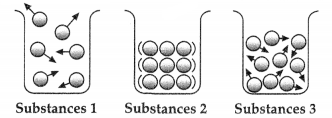
Which of the following is true about the state of the three substances?
(A) Substance 1: Solid, Substance 2: Liquid, Substance 3: Gas
(B) Substance 1: Gas, Substance 2: Liquid, Substance 3: Solid
(C) Substance 1: Liquid, Substance 2: Gas, Substance 3: Solid
(D) Substance 1: Gas, Substance 2: Solid, Substance 3: Liquid
Answer:
Option (D) is correct
Explanation: In solids, molecules are tightly packed as compared to liquid and gas. Substance 3 is solid as molecules are closely packed. Molecules in liquids are slightly loose while molecules in gases are very loosely packed. Hence, substance 2 is liquid and substance 1 is gas.
Question 2.
Rusting of an article made up of iron is called: [1]
(A) Corrosion and it is a physical as well as chemical change.
(B) Dissolution and it is a physical change.
(C) Corrosion and it is a chemical change.
(D) Dissolution and it is a chemical change.
Answer:
Option (C) is correct.
Explanation: Rusting of an article made up of iron is called corrosion. Corrosion is a chemical change because rust is a chemical compound (hydrated iron oxide), which is totally different from elemental iron (Fe).
Question 3.
In which of the following conditions, the distance between the molecules of hydrogen gas would increase? [1]
(i) Increasing pressure on hydrogen contained in a closed container.
(ii) Some hydrogen gas leaking out of the container
(iii) Increasing the volume of the container of hydrogen gas.
(iv) Adding more hydrogen gas to the container without increasing the volume of the container
(A) (i) and (ii)
(B) (i) and (iv)
(C) (ii) and (iii)
(D) (ii) and (iv)
Answer:
Option (C) is correct.
Explanation: Some hydrogen gas leaking from the container leaves some vacant space inside the container. So, hydrogen gas molecules inside the container will occupy all the space available and the distance between the molecules of hydrogen gas will be increased.
True
False
Question 4.
The formula and charge on ions of three different compounds are shown below.
Two ions, Zn
2+
and S
2-
,combine to form a compound. What should be the formula of the compound formed? [1]
(A) ZnS
(B) Zn
2
S
(C) ZnS
2
(D) Zn
2
S
2
Answer:
Option (A) is correct.
Explanation: Two ions, Zn
2+
’ and S
2-
, will form compound ZnS, as each of them has valency 2.
Question 5.
The number of electrons in an element X is 15 and the number of neutrons is 16. Which of the following is the correct representation of the clement? [1]
(A)
15
31
X
(B)
16
31
X
(C)
16
15
X
(D)
16
15
X
Answer:
Option (A) is correct.
Explanation: Given that, number of electrons in element X = 15 and number of neutrons = 16.
Atomic number = Number of protons = Number of electrons in neutral atom = 15
Mass number = number of protons + number of neutrons = 15 + 16 = 31
So, correct representation of element is
15
31
X.
Question 6.
Choose the correct statement of the following. [1]
(A) Conversion of solid into vapours without passing through the liquid state is called vaporisation.
(B) Conversion of solid into vapour without passing through the liquid state is called sublimation.
(C) Conversion of vapours into solid without passing through the liquid state is called freezing.
(D) Conversion of solid into liquid is called sublimation.
Answer:
Option (B) is correct
Explanation: The conversion of liquid into gas (vapour) is called vaporisation. The conversion of liquid into solid is called freezing. The conversion of solid into liquid is called melting.
Question 7.
Two chemical species X and Y combine together to form a product P which contains both X and Y. X + Y → P, X, and Y cannot be broken down into simpler substances by simple chemical reactions. Which of the following concerning the species X, Y, and P are correct? [1]
(1) P is a compound.
(ii) X and Y are compounds.
(iii) X and Y are elements.
(iv) P has a fixed composition.
(A) (i), (ii) and (iii)
(B) (i), (ii) and (iv)
(C) (ii), (iii) and (iv)
(D) (i), (iii) and (iv)
Answer:
Option (D) is correct.
Explanation: In this reaction, X and Y cannot be broken down into simpler substances by chemical reactions; therefore, X and Y are elements A compound is a substance made up of two or more elements chemically combined in a fixed proportion by mass; therefore, P is a compound, having a fixed composition.
Question 8.
Which of the following are covered by a single membrane? [1]
(A) Mitochondria
(B) Vacuole
(C) Lysosome
(D) Both (B) and (C)
Answer:
Option (D) is correct
Explanation: Vacuole and lysosome are covered by a single membrane while mitochondria and plastid have a double membrane.
Question 9.
In desert plants, rate of water loss gets reduced due to the presence of: [1]
(A) Cuticle
(B) Stomata
(C) Lignin
(D) Suberin
Answer:
Option (A) ¡s corred.
Explanation: Cuticle minimises the water loss through transpiration (with the help ol stomata) and also reduces pathogen entry.
Question 10.
Cell theory was given by: [1]
(A) Schleiden and Schwann
(B) Virchow
(C) Hooke
(D) Haeckel
Answer:
Option (A) is correct.
Explanation: Schleiden (1836) and Schwann (1834) gave the cell theory which states that all the plants and animals are composed of cells and cell is the basic unit of life.
Question 11.
The water-conducting tissue generally present in gymnosperm is: [1]
(A) Vessels
(B) Sieve tube
(C) Tracheids
(D) Xylem fibers
Answer:
Option (C) is correct.
Explanation: The gymnosperms are characterised by the presence of tracheids as their major conducting tissue.
Question 12.
Voluntary muscles are found in: [1]
(A) Alimentary canal
(B) Limbs
(C) iris of the eye
(D) Bronchi of lungs
Answer:
Option (B) is correct.
Explanation: Voluntary muscles are the muscles, which are under our complete control. Example includes the muscles that control working and movement of limbs.
Question 13.
The numerical ratio of displacement and distance for a moving object is: [1]
(A) Always less than 1
(B) Always equal to 1
(C) Always more than 1
(D) Equal to or less than 1.
Answer:
Option (D) is correct.
Explanation: Displacement of an object can be less than or equal to the distance covered by the object, because the magnitude of displacement is not equal to distance. However, it can be same, if the motion is along a straight line without any change in direction.
Question 14.
The work done on an object does not depend upon the: [1]
(A) Displacement
(B) Force applied
(C) Angle between force and displacement
(D) Initial velocity of the object.
Answer:
Option (D) is correct.
Explanation: We know that,
W = F. d cos θ.
Here, F = force applied on the object, d = dis placement, and θ is angle between force and displacement. So, the work done on an object does not depend upon the initial velocity of the object.
Question 15.
Cattle husbandry is done for the following purposes. [1]
(i) Milk production
(ii) Agricultural work
(lii) Meat production
(iv) Egg production
(A) (i), (ii) and (iii)
(B) (ii), (iii) and (iv)
(C) (iii) and (iv)
(D) (i) and (iv)
Answer:
Option (A) is correct.
Explanation: Human beings domesticate cattle for milk production, agricultural work, meat production, transportation and leather, etc.
Question 16.
Oysters are cultivated in inland water bodies for food.
What else can he obtained from the cultivation of oysters? [1]
(A) Pearl
(B) Sponge
(C) Platinum
(D) Sand
Answer:
Option (A) is correct.
Explanation: Oysters are cultivated for obtaining pearls.
False
Question No. 17 to 20 consist of two statements – Assertion (A) and Reason (R). Answer these questions selecting the appropriate option given below:
(A) Both (A) and (R) are true, and (R) is the correct explanation of (A).
(B) Both (A) and (R) are true, and (R) is not the correct explanation of (A).
(C) (A) is true but (R) is false.
(D) (A) is false but (R) is true.
Question 17.
Assertion (A): Particles of gas intermix with each other.’
Reason (R): The intermixing of particles of two different types of matter on their own is called diffusion. [1]
Answer:
Option (A) is correct.
Explanation: Particles of a gas are loosely packed. So, they move randomly due to space between them and intermix with other particles present there.
Question 18.
Assertion (A): Lysosomes are known as suicidal hag of cells.
Reason (R): Lysosomes contain powerful enzymes capable of breaking down all organic material. [1]
Answer:
Option (A) is correct.
Explanation: During the disturbance in cellular metabolism lysosomes may burst and the enzymes digest their own cell. Therefore, lysosomes are also known as suicidal bags. Lysosomes are able to do this because they contain powerful enzymes capable of breaking down all organic material.
Question 19.
Assertion (A): Velocity is the speed of an object in a particular direction.
Reason (R): SI unit of velocity is same as speed. [1]
Answer:
Option (B) is correct.
Explanation: Velocity is the speed of an object moving in a direction, or the displacement of an object in unit time. Speed, on the other hand, is the distance travelled by an object in the given time. SI unit of velocity is same as speed i.e., m/s.
Question 20.
Assertion (A): Italian bee is commonly used for honey production.
Reason (R): Italian bees have high honey-collecting capacity, are stingless, and breed very well. [1]
Answer:
Option (A) is correct.
Explanation: An Italian bee, Apis melifera, is commonly used for honey production. It has high honey collecting capacity, is stingless, breeds very well arid staVs in bee hive for long periods.
Section – B
(Question No. 21 to 26 arc very short answer questions)
‘Question 21.
The electronic configuration of an element ‘X’ is 2, 8, 2.
(a) Find the number of electrons present in the atom of element ‘X’.
(b) Write its atomic number.
(c) Is element ‘X’ a meta I or a non-metal?
(d) Find out the valency of the element ‘X’. [2]
Answer:
(a) 12
(b) Atomic number = 12
(c) “X’ is a metal as it has two outer electrons that it can bosse quickly.
(d) Valency of T is + 2.
Question 22.
Write the main functions of cell wall. [2]
Answer:
(i) Cell wall provides shape as well as rigidity to the cell.
(ii) It protects the protoplasm.
(iii) Growth of cell wall determines the growth of cell.
Question 23.
What is apical meristem? What is its function? [2]
OR
Give differences between cytoplasm and nucleoplasm.
Answer:
Apical meristems are the meristematic tissues which are found at the growing tips of stems and roots.
They increase the length of the stems and roots and are responsible for the growth of plants.
OR
Differences between cytoplasm and nucleoplasm:
| Cytoplasm | Nucleoplasm |
| (i) Cytoplasm is the protoplasm which lies outside the nucleus, i.e., between the nucleus and the cell membrane. | It is the part of protoplasm that lies inside the nucleus. |
| (ii) It contains various organdies and inclusions. | It is a colloidal substance having similar composition to cytoplasm but contains more of nucleotides. |
| (iii) It contains a number of inorganic substances forming clear true solution as well as organic substances lipids, protein, and carbohydrates. | It contains chromatin material. |
Question 24.
In which of these conditions is the work done negative? [2]
| (i) Wind force making a boat move forward on water. |
| (ii) Brake force resisting the motion of a moving wheel. |
| (iii) Buoyant force slowing the sinking of an iron nail in water. |
Answer:
Negative work is done when the displacement is in the opposite orientation of the force delivered. So, the work done is negative in:
(ii) Brake force resisting the motion of a moving wheel.
(iii) Buoyant force slowing the sinking of an iron nail in water.
Question 25.
The velocity-time graph shows the motion of a cyclist. Find (i) the cyclist’s acceleration, (ii) higher velocity after 20 s. [2]
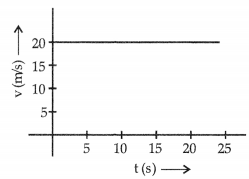
OR
State why Newton’s first law of motion is called law of inertia.
Answer:
a = 0 because velocity is constant.
ν= 20 m/s (same reason as above)
OR
Inertia is the tendency of the object to resist change in its state. Newton’s first law of motion also states the same, i.e., the object will remain in its present state unless an external force is applied. That is why Newton’s first law is called law of inertia.
Question 26.
The picture shows how organic manure and chemical fertilizer are used by plants.
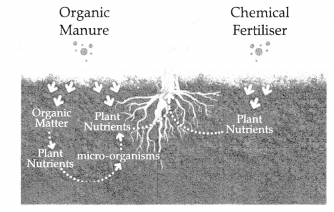
(a) Which of the two, organic manure and chemical fertiliser, provides food for the soil microorganism?
(b) Which of the two, organic manure and chemical Ierhliser is not harmful for the environment? Why? [2]
Answer:
(a) Organic manure
(b) Organic manure is not harmful for the environment as it is biodegradable.
Section – C
(Question No. 27 to 33 are short answer questions)
Question 27.
(a) How can we say that sugar is a pure substance whereas milk is not?
(b) Which of the following materials fall in the category of a pure substance?
(i) Ice
(ii) Iron
(iii) Wood
(iv) Brick [3]
Answer:
(a) Sugar is a pure substance because it cannot be separated and is formed of only single type of molecule. In the case of milk, it can be separated by physical process into its components. It has components like water, fat and proteins, etc.
b) Ice and iron are pure substances as they contain particles of only one kind of matter while wood and brick contain more than one kind of matter.
Question 28.
Give three reasons to justify that water is a liquid at room temperature. [3]
OR
Atomic number and mass number of an element are 18 and 40 respectively. Identify the element and write the number of electrons and neutrons present in its atom. Show the schematic atomic structure of the atom.
Answer:
At room temperature, water is liquid because it has the following characteristics of liquid:
(i) At room temperature, water has no shape but has a fixed volume.
(ii) It takes the shape of the container in which it is kept.
(iii) It can flow
OR
Name of element: Argon
Number of electrons = 18
Number of neutrons = 22 (40-18)
Structure: 2, 8, 8
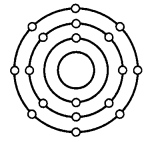
Question 29.
Where are chromosomes present in the cell? What is their chemical composition? How many pairs of chromosomes are present in humans? [3]
Answer:
Chromosomes are present in the nucleus of a cell. Their chemical composition is of DNA, and proteins.
Humans have 23 pairs of chromosomes.
Question 30.
Describe the structure, function, and location of the nervous tissue. [3]
Answer:
Structure: The nervous tissue is made up of neurons which consist of a cell body with a nucleus and cytoplasm. From the cell body, long thin hair-like parts called dendrites arise.
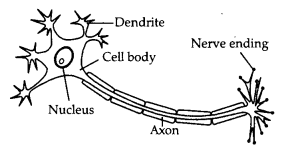
Function: On stimulation, the nerve cells transmit the stimulus very rapidly from one place to another within the body.
Location: Nervous tissues are located in the brain, spinal cord, and nerves.
Question 31.
(a) Define power. Derive its SI unit.
(b) An electric bulb is rated 15 watts. What does it mean?
(c) What is the energy consumed in joules if it is used for 10 minutes? [3]
Answer:
(a) Power is the rate of doing work. 1
Power = \(\frac{\text { Work }}{\text { Time }}=\frac{1 \text { Joule }}{1 \text { second }}\) 1 watt or 1 W
(b) If the power of an electric bulb is 15 W it consumes 15 Joules of energy per second.
(c) Energy consumed by the bulb in 10 minutes 15 W x 600s = 9000 Joules
Question 32.
A man’s weight when taken at the poles is 600 N. Will his weight remain the same when measured at the equator? Will there be an increase or decrease in his weight? Explain. [3]
Answer:
No, his weight will not remain same as that at the poles. There will be a decrease in his weight at the equator. As the radius of the Earth increases from the poles to the equator, the value of ‘g’ becomes greater at poles decreasing towards equator. Also, the force of gravity decreases from poles to the equator.
Question 33.
(a) State Archimedes’ principle.
(b) State the laws of floatation.
(c) Why is it easier to swim in sea water than in river water ? [3]
Answer:
(a) Archimedes’ principle, states that when a body is immersed fully or partially in a fluid, it experiences an upward force that is equal to the weight of the liquid displaced by it.
False
- When the weight of the object is more than the buoyant force exerted by a fluid on the object, then the object sinks.
- When the weight of the object is less than the buoyant force exerted by the fluid on the object, then the object floats.
(c) Sea water has a higher density than river water. So, it will exert higher buoyant force than river water on the same object.
So, in order to swim, less amount of water needs to be displaced to balance our weight. Therefore, it is easier to swim in seawater.
Section – D
(Question No. 34 to 36 are long answer questions)
Question 34.
How the water changes into vapours at temperature below its boiling point? List the factors affecting evaporation. Mention two examples from daily life where evaporation causes cooling. [5]
OR
(a) Explain the term diffusion. Illustrate with an activity that rate of diffusion increases with temperature.
(b) Name two compressed gases (i) used in our homes for cooking (ii) supplied to hospital in cylinders. [5]
Answer:
The phenomenon of change of a liquid into vapour at a temperature below its boiling point is called evaporation. Fractions of particles at the surface having higher kinetic energy, are able to break away from the forces of attraction of other particles and get converted into vapour.
False
- Surface area
- Temperature
- Humidity
- Wind speed
Two examples from daily life where evaporation causes cooling:
Sprinkling of water on the roof, cooling of water kept in earthen pots, etc.
OR
(a) Diffusion is the process resulting from random motion of molecules by which there is a net flow of matter from a region of high concentration to a region of low concentration. During diffusion particles of one substance occupy the vacant space present between the particles of the other substance.
________________________________________________________________________________________________________________
- Take 5 g of copper sulphate each in three beakers.
- Pour 100 ml of distilled water slowly in one of the beakers.
- Cover this beaker with a watch glass.
- Pour 100 mi of cold cater in the second beaker slowly.
- Place the third beaker containing 100 ml of water on a tripod stand for heating.
- Observe the diffusion process which begins in all the beakers.
- Record the time taken for the dissolution of copper sulphate in all the three cases.
Conclusion: The rate of diffusion of copper sulphate in water is in the order:
Beaker 3> Beaker 2> Beaker 1.
It illustrates with that rate of ditfusion increases with increase in temperature.
(b) Gas used in our home for cooking: Gas used in our home for cooking: Gas used in our home for cooking: Gas used in our home for cooking: Gas used in our home for cooking: Gas used in our home for cooking: Gas used in our home for cooking: Gas used in our home for cooking: Gas used in our home for cooking: Gas used in our home for cooking: Gas used in our home for cooking: Gas used in our home for cooking: Gas used in our home for cooking: Gas used in our home for
- liquified Petroleum Gas (LPG) Gas supplied to hospital in cylinder:
- Oxygen.
Question 35.
(a) Explain the terms:
(i) Endocytosis,
(ii) Plasmolysis.
(b) What wifl happen if the organisation of a cell is damaged due to certain physical or chemical reasons?
(c) How do substances like CO
2
and water move in and out of the cell?
OR
Identify the type of tissues in the following:
(a) Vascular bundle
(b) Inner lining of the intestine
(c) lining of the kidney tubule
(d) Iris of the eye
(e) Muscles of the heart
Answer:
(a)
(i) Endocytosis: The flexibility of the cell membrane enables the cell to engulf food and other materials from its external
environment. Such process is known as endocytosis.
True
when the organisation of a cell gets damaged, lysosomes will burst . their enzymes will eat up their own cell organelles . therefore, lysosomes arc also known as the “suicidal bags of the cell”.
(c) Gases like CO
2
and O
2
move in and out of the cell by diffusion from their higher concentration to lower concentration. Water enters the cell by endosmosis through a semi-permeable plasma membrane from its higher concentration to its lower concentration. Similarly, water moves out of the cell by exosmosis when a cell is
placed in a hypertonic solution.
- Complex tissues
- Columnar epithelium
- Cuboidal epithelium
- Involuntary muscular tissues
- Cardiac muscles
Question 36.
(a) A stone is thrown upwards from a point A, as shown in the figure. After reaching the highest point B it comes down. Explain the transformation of energy from A to B and B to A and also mention the type of energy possessed by the stone at points A, B, and C of its journey.
(b) A body of mass 20 kg is dropped from a height of 101 m. Find its K.E. and PE. after (i) 1st second (ii) 2nd second (iii) 3rd second. [5]
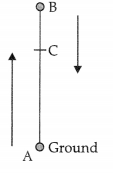
OR
(a) State the law that provides the formula for measuring force and the law which provides the definition of force.
(b) Velocity time graph of a 50 g marble rolling on a floor is given below. Find:
(i) time in which it stops. ‘
(ii) negative acceleration produced on it.
(iii) positive force acting on the marble.
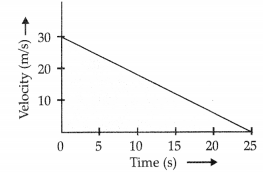
The definition of force is given by Newton’s first law
Answer:
(a) While going up, K.E → P.E. and while coming down P.E. → K.E.
At A → K.E
B → P.E.
C →K.E + P.E
(b) Total Energy = mgh
= 20 × 10 × 100
= 2 × 10
4
J
(i) After 1st” second:
ν = u + gt = 10 × 1
= 10 m/s (u =0)
K.E. = \(\frac{1}{2}\)
= \(\frac{1}{2} \times 20 \times 10 \times 10\)
= 1000 J
P.E = T.E. – K.E = 20,000-l000
=19,000 J
(ii) After 2nd second:
ν = 20 ms
-1
’
K.E. = \(\frac{1}{2} m v^2=\frac{1}{2} \times 20 \times 20 \times 20 \)
= 4,000 J
P.E. = T.E. – K.E.
= 20,000 – 4,000 = 16,000 J
(iii) After 3rd second:
ν = 30ms
-1
K.E. = \(\frac{1}{2} \times 20 \times 30 \times 30 \)
= 9,000 J
PE. = T.E. – K.E.
= 20,000- 9,000 = 11,000 J
OR
Newton’s 2nd law gives us a method to measure the force acting on an object as force is the product of its mass and acceleration . second law of motion gives us a method to measure the force acting on an object as force is the product of its mass and acceleration .
Definition of force is given by Newton’s first las it states that an obect continues to be in a state of rest or a body in motion will remain in uniform motion along a straight line unless acted upon by an unbalanced force.
(b) From graph
(i) t =25s
(ii) a = \(\frac{(30-0)}{25}\) = 1.2 m/s
2
(iii) F =ma
= \(\left(\frac{50}{1000}\right)\) × 1.2 = 0.06 N
Section – E
(Question No. 37 to 39 are case-based) data-based questions with 2 to 3 short sub-parts. Internal choice is provided in one of these sub-parts.)
Question 37.
The table lists the properties of four substances.

(a) Which of the substances is likely to be a metal?
(b) Which of the substances is likely to he a metalloid?
(c) Which of the substances is/are likely to he a nonmetal? Why?
OR
Can substance 2 or substance 4 he used to prepare electric circuit wires? Why? [4]
Answer:
(a) Substance 1, as it is shiny and conducts electricity very well.
(b) Substance 3 1
(c) Substance 2/suhstance 4, as not shiny and poor conductor ol electricity.
OR
No, substance 2 or substance 4 cannot be used to prepare electric circuit wires as they are bad conductors of electricity.
Question 38.
Study the given diagram and answer the following questions.
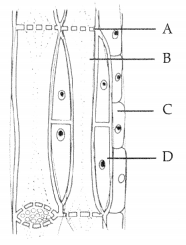
(a) Name the tissue shown in the diagram.
(b) Which fissues together make vascular bundles?
(c) Identify the parts A, B, C, and D. [4]
OR
What will happen if phLoem at the base of the branch is removed?
Answer:
(a) Phloem I
(b) Vascular Bundles are composed of xylem and phloem together.
(c) A – Sieve plate, B – Sieve tube, C – Phloem parenchyma D- Companion cycle 2
OR
If the phlœm at the hase of branch is removed, then lower area of the branch will not receive food from the leaves. But the plant will not die, as it will continue to receive food from other branches as food can move in phloem in both
directions.
Question 39.
Study the following graph and choose the correct options to answer the following questions given below:
The velocity-time graph of an object is shown in the following figure.
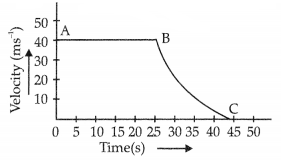
(a) State the Kind or motion that objects has, from A to B and from B to C.
(b) What does the area enclosed by the velocity-time graph represent?
(c) Identify the part of graph where the object has zero acceleration. Give reasons for your answer. [4]
OR
Identify the part of graph where the object has negative acceleration. Give reasons for your answer.
Answer:
(a) Uniform motion from A to B and non-uniform motion from B to C.
(b) Displacement
(c) AB because velocity remains constant from A to B.
OR
BC because velocity decreases from B to C.